50 years ago, the last regular expresses hauled by pre-Nationalisation express steam engines ended; the LMS Jubilee’s last regular turns being on the Settle & Carlisle line.
It was 13 years before the line saw the return of a Jubilee… but 50 years on from the withdrawal of the last three of the class, this has again become commonplace. Brian Sharpe examines the long and ongoing relationship between Stanier’s express 4-6-0s and England’s most scenic main line.

In July 1967, steam traction ended on the Southern Region and it would only be a further 13 months before the total elimination of steam on BR.
Enjoy more Heritage Railway reading in the four-weekly magazine.
Click here to subscribe & save.
Although there were still steam-hauled express trains in the North West after the summer of 1967, the regular ones were mainly the ‘Belfast Boat Express’and short Blackpool/Liverpool/Manchester portions of expresses from Euston or Glasgow. Traction was usually provided by LMS ‘Black Five’ mixed traffic 4-6-0s, with even the remaining BR Standard Britannia Pacifics seeing little express action.
The last of the true ‘Big Four’ express steam engines on the London Midland Region, Stanier Jubilee 4-6-0 No. 45627Sierra Leone,had been withdrawn from Liverpool’s Bank Hall shed in September 1966, but fortunately some of the class survived at Eastern Region sheds in the West Riding; the ER having merged with the NER in September 1967. There appeared to be a genuine desire to keep the West Riding Jubilees going and to use them on express workings if at all possible.
‘Red Fives’
Stanier’s 191-strong 5XP express 4-6-0s, painted maroon, became known initially as ‘Red Fives’. Henry Fowler’s parallel-boilered Patriot 4-6-0s were still being built when the new 5XPs were introduced in 1934, but the last five were built with Stanier’s taper boiler and so became the first of the new class.
Introduced along with the ‘Black Five’ 4-6-0s and in a bit of a hurry, with 113 going straight into service, they were not a great success and comments from footplate crews included the classic “the black ’uns are alright but the red ’uns won’t steam”. The moderate degree of superheating on the 5XPs was partly to blame but changes to the blastpipe and chimney dimensions helped transform them, although they could still be temperemental.
On April 29, 1935 No. 5552, the first of the class, permanently swapped identities with No. 5642 which had been named Silver Jubilee10 days earlier in recognition of the Silver Jubilee of King George V on May 6, but it was the decision to swap identities with No. 5552 so that Silver Jubileebecame the first engine, carrying unlined black livery with chrome embellishments, that led to the familiar Jubilee class name.
A consistent naming theme was impossible for such a large class, so once Commonwealth countries and states were exhausted, there was a series of admirals and naval commanders and then British Navy warships, mostly originally characters in Greek mythology but with quite a mixture of the various themes towards the end.
Midland main line
They are often associated with the former Midland main lines where they represented a big increase in power over the Compound 4P 4-4-0s, and right up until the late 1950s, monopolised express workings out of
St Pancras with Royal Scots being a comparative rarity south of Leeds until some were released from the WCML after partial dieselisation. With so many engines, the class could be found on main lines throughout the former LMS system.
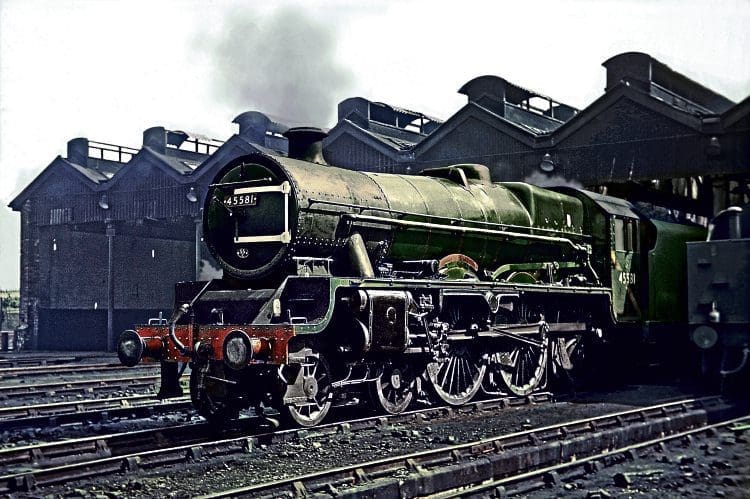
The former Midland routes radiating from Derby and Nottingham, to Bristol, St Pancras, Manchester and Carlisle via Leeds were among the priorities to be provided with Jubilee power. Leeds Holbeck shed received its first four class members on December 18, 1934, and the allocation rose to 25 by 1940, although it reduced after the war. Among Holbeck’s duties were expresses to Glasgow via the Settle & Carlisle and GSW routes, and this started the Jubilees’ long association with the S&C, although they lost many of their top jobs on the line to newly-rebuilt Royal Scots in the 1940s.
One of Holbeck’s engines; No. 5660 Rookewas involved in four days of tests in October 1937 to see if Bristol – Leeds – Glasgow expresses could be accelerated. On October 14, the engine achieved an even time run from Carlisle to Ais Gill summit with a 305 ton train. In fact the engine was generally worked harder on the sections south of Leeds but it proved what the engines were now capable of.
There were a number of detail differences, the most obvious being that some entered service with Fowler tenders. In January 1951, the power classification was changed from 5XP to 6P and to 6P5F in November 1955. Two were rebuilt in July 1943, being reclassified 6P and 7P in 1951 under BR. These engines were closer to the rebuilt Royal Scot design than the Jubilee. No. 45637 Windward Islandswas scrapped in 1952 after the Harrow & Wealdstone crash and normal withdrawals started in 1960, with only a handful surviving into 1966.
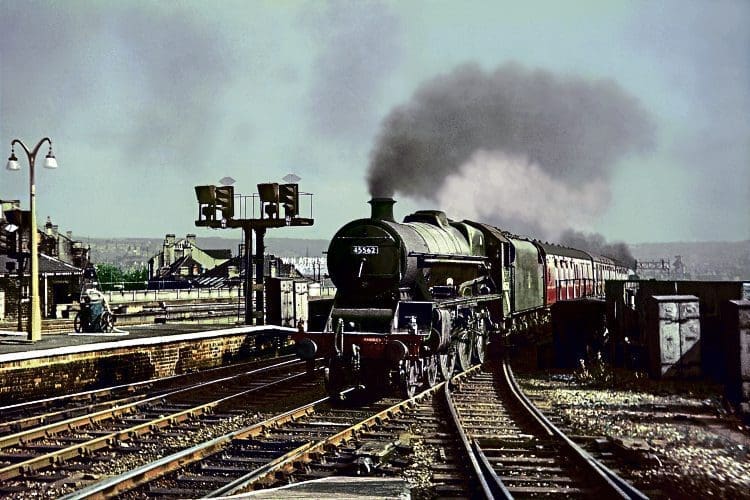
Although now virtually extinct on the LMR, the summer of 1966 still saw summer Saturday trains from the West Riding to East Coast resorts regularly rostered for Jubilee haulage as well as frequent workings to Blackpool and North Wales and still occasional trips to Glasgow. Another regular job was the summer Saturday Leeds-Poole train as far as Nottingham, routed via Penistone and Barnsley. Various other relief trains had the benefit of Jubilee haulage but the class members spent much of their time on freight and parcels duties. August 1966 saw Farnley Junction’s No. 45581 Bihar and Orissawithdrawn; the first NER casualty since Holbeck’s No. 45574Indiain March that year.
Allocation of five
Farnley’s other two Jubilees; Nos. 45562 Albertaand 45647 Sturdeewere transferred to Holbeck, giving that shed an allocation of five of the class at the start of 1967. Meanwhile Nos. 45694 Bellerophonand 45739 Ulsterwere still soldiering on at Wakefield along with
No. 45565 Victoria at Low Moor but this ended with their withdrawal in January 1967.
Holbeck withdrew No. 45647 Sturdeein April 1967 and No. 45675 Hardy in June; the latter having found itself working from York during the spring, including passenger services to Hull. By this time it was clear that steam would end in the West Riding at the end of the summer timetable on September 30. Every effort was made to keep the last three survivors going up to the end though with No. 45562 Alberta,No. 45593 Kolhapurand No. 45697 Achillesbeing the preferred power for two northbound summer Saturdays-only expresses from Leeds to Carlisle.

The trio were kept in immaculate condition by shed staff under Tom Greaves, the enthusiastic district motive power superintendent, sometimes assisted by a dedicated band of clandestine engine cleaners from the enthusiast community. No. 45697 Achillesalways seemed to be the least-favoured of the three while the star of the trio tended to be No. 45562 Alberta,which even worked the Royal train on May 30 conveying the Duke of Edinburgh from York to Nidd Bridge; becoming the last steam engine to haul the train in BR days. There were other occasional express workings with No. 45593 making its last trip to Blackpool on Wednesday August 10.
No. 45562 hauled the last 10.17 Leeds – Carlisle on August 26; No. 45697 was withdrawn and the other two saw little more action but No. 45562 was rostered for a Hunslet – Carlisle freight on September 30. As late as October 7, Nos, 45562 and 45593 double-headed a railtour from Bradford to Carlisle via Shap, returning over the S&C. Even that was not the end as Albertahad one final fling on October 28 on a fairly short leg of a railtour around the West Riding, shortly after having made a trip up to Tyneside to provide overnight steam heat for the Royal train.
A year earlier, the penultimate Jubilee on the London Midland Region to be withdrawn, the unique double-chimneyed No. 45596 Bahamashad been purchased for preservation by the Bahamas Locomotive Society.
No. 5596 was built by North British in Glasgow toward the end of 1934, entering traffic in January 1935 allocated to Crewe It was named Bahamasin June 1936.
It was well-travelled and also worked from Preston, Camden, Willesden, Kentish Town and Derby before the war and Grimesthorpe, Millhouses and Bristol during the war before returning to Crewe by 1947. In BR days as No. 45596, it was allocated to Edge Hill and was unique in being fitted with a double chimney at Crewe in May 1961. This turned out to be the last experiment by BR to improve the performance of its steam locomotives, and although tests suggested a significant improvement in steaming, it had all taken too long and the BR experiments terminated in 1962 without any further Jubilees receiving double chimneys.
No. 45596 was returned to traffic based at Carlisle, but was transferred to Stockport Edgeley in July 1962, from where it was withdrawn in July 1966, by then the last-but-one of the class in service on the LMR.
Engine was purchased
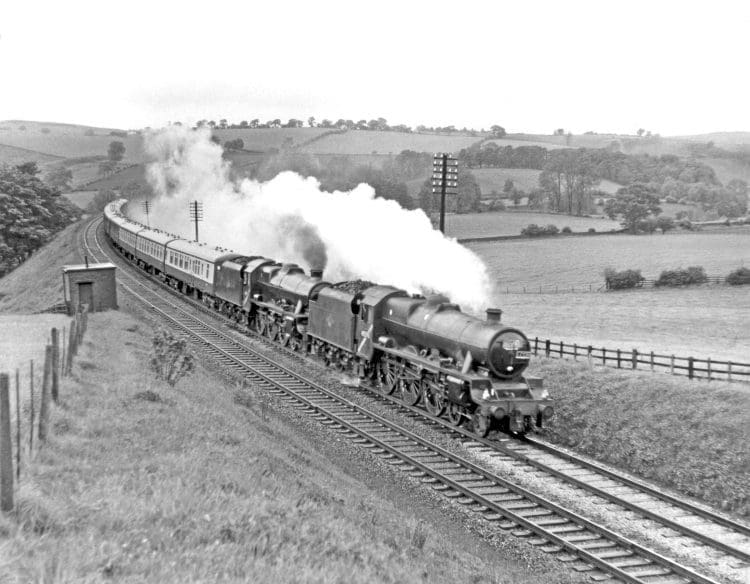
After a successful fundraising campaign, the engine was purchased by the Bahamas Locomotive Society in 1967 and sent to Hunslets in Leeds in September 1967 for overhaul and a repaint into its LMS maroon livery, returning to Edgeley on March 11, 1968.
Edgeley shed was never going to be a permanent base and after the closure of the shed towards the end of BR steam in the north-west in May 1968, Bahamaswent into store at Bury shed. However, the society located a suitable permanent base and took a lease on the one-time one road GCR locomotive shed at Dinting, the junction for Glossop on the Woodhead line. Bahamasarrived at Dinting under its own steam on November 15, 1968.
This led to the creation of the Dinting Railway Centre, which grew to be an important centre for main line steam. Bahamaswas selected for use on main line tours after the lifting of the BR ban in 1972 and worked its first railtour, from Guide Bridge to Sheffield via the Hope Valley in June 1973 After a run on the Welsh Marches route in October though, boiler repairs were found necessary and Bahamashad to wait a very long time for these; in fact the overhaul did not start until 1980 and was to take eight years.
Fortunately on the withdrawal of the last three Jubilees from Holbeck in 1967, No. 45593 Kolhapurwas also purchased for preservation. It moved under its own steam to Tyseley on October 20, having swopped tenders, smokeboxes and other parts with Alberta. Albertaand Achilleswere stored at Normanton until despatched to Cashmore’s at Great Bridge for scrapping in early 1968.
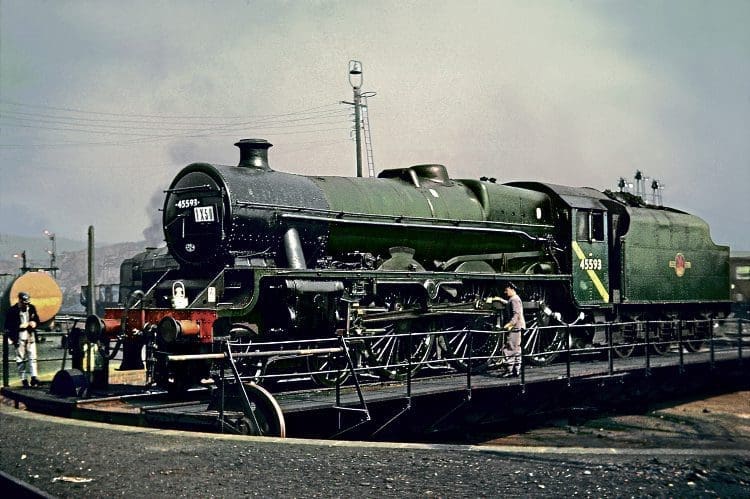
No. 5593 was built in 1934 by North British of Glasgow, and in May 1936 in accordance with the Commonwealth theme of the naming policy for the class, was named Kolhapurafter a state in western India. Kolhapurhad the distinction of hauling the train carrying Sir Winston Churchill from Liverpool on his return from the North Atlantic Treaty talks with President Roosevelt in the USA in 1942.
It was another well-travelled engine and spent time at various sheds on the LMR in BR days, including Longsight, Carlisle Upperby, Willesden, Aston, Burton, Patricroft and Newton Heath, until transferred to Holbeck in the North Eastern Region on March 23, 1965. As such it tended to be regarded as a bit of an interloper in the West Riding; most of the Jubilees in the area having been allocated there for many years.
Kolhapurwas bought by the then Standard Gauge Steam Trust and restored to LMS maroon livery, regularly appeared at the extremely popular Tyseley open days, which were the nearest thing to working main line steam during the BR ban. Although it travelled further afield a couple of times it was not at the head of a main line passenger train and although on the ‘approved’ list when the BR ban was lifted, it required boiler work and remained out of steam for many years.
Barry scrapyard
Although two Jubilees were preserved on withdrawal and at times have regained their former glories on the main line, two other much earlier withdrawals found their way to Barry scrapyard and these two former Bristol engines which had ended their careers in 1964 have become rather better-known on the main line in recent years than Bahamasor Kolhapur.
No. 5690 Leanderwas built at Crewe in March 1936 and named after HMS Leander,which in turn was named after the Greek hero of the same name. After Nationalisation in 1948, Leanderwas based at Bristol (Barrow Road) shed.

After withdrawal in 1964, Leanderwas sold to Woodham’s scrapyard at Barry, from where it was rescued by Brian Oliver in May 1972. It was restored at Derby works and having returned to steam in LMS maroon livery as
No. 5690 in June was based at the Dinting Railway Centre from August 25, 1973.
Its railtour debut was on the Hope Valley route on September 1, 1973, at which point it took over from No. 5596 Bahamasas the centre’s main line flagship, but a move to Steamtown Carnforth took place on
February 24, 1979 at the head of a railtour from Guide Bridge via Sheffield, York and Leeds.
A period of regular main line use followed and it was in April 1980 that the familiar Jubilee roar was heard once again on the ‘Long Drag’ as Leanderheaded its first train over the S&C; a then-rare out and back working from Hellifield to Carlisle and back. Carrying LMS maroon livery and hauling a uniform rake of BR blue & grey coaches, it was not quite like the Jubilee-hauled expresses of 13 years earlier but it heralded appearances of the class on the route which were to become more frequent in years to come.
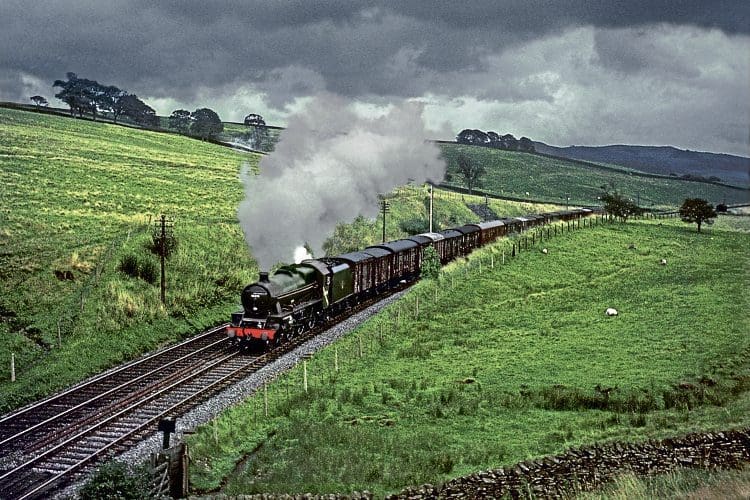
The engine also made a working visit to the Severn Valley Railway from August 1980, starring in the September gala weekend.
Meanwhile No. 5593 Kolhapurwas overhauled at Tyseley and finally returned to the main line; its inaugural run being at the head of HRH The Duke of Gloucester’s Royal Train from Tyseley to Birmingham Moor Street on June 5, 1985. After this, various runs took place mainly in the Midlands. March 1987 finally saw Kolhapurmaking a welcome return to the Settle & Carlisle line, no less than 20 years after the engine had been one of the three stars on the route. It was in LMS maroon livery and hauling a train of coaches in very mixed liveries.
BR green livery
No. 45596 Bahamashad also been under long-term overhaul since 1980 but returned to the main line in 1989, resplendent in authentic BR green livery. After a few runs on other routes, Bahamaswas quick to return to the S&C, making its first trips in August 1989, with two northbound and two southbound runs, bringing back the sight of a BR green Jubilee and a full rake of maroon Mk.1 coaches to the line for the first time since 1967.
The Dinting Railway Centre closed in 1991 and the society and its collection moved to Ingrow West on the Keighley & Worth Valley Railway, but Bahamascontinued to make regular main line appearances until its boiler certificate expired but again it would be a long time before the next overhaul could be completed.
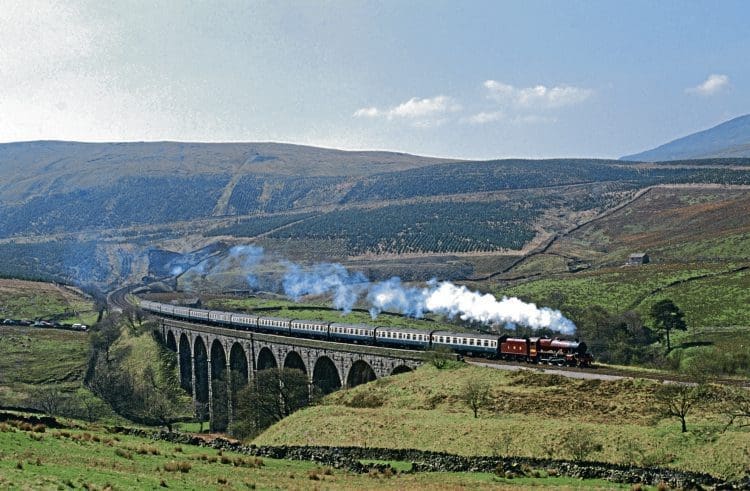
No. 5690 Leandermoved to the Severn Valley Railway on a permanent basis in April 1984, becoming the line’s main line flagship. After later purchase by the railway it continued to run on the SVR and the main line, until the SVR pulled out of main line operations and
it was decided that Leander was too big for purely internal services. Leanderwas sold to
Dr Peter Beet, the original founder of Steamtown Carnforth, in January 1995, but was restored on the East Lancashire Railway, entering service in 2002. It was several years before No. 5690 saw main line use again though, when it did a series of tours in 2005/6 based at Tyseley. Dr Beet died and in April 2012, Leanderwas withdrawn for overhaul.
Greek mythology
Like Leander,the other Barry survivor; No. 5699 Galateawas also one of the later Jubilees, built at Crewe in April 1936. Like many of the class it was named after a Royal Navy warship HMS Galateawhich had in turn been named after a character in Greek mythology.
In early BR days, the engine worked from Bristol Barrow Road shed but moved to Shrewsbury in October 1961 from where it was withdrawn in November 1964. Stored briefly at Eastleigh works, it was sold to Woodham’s scrapyard at Barry in January 1965.
While Leanderbecame an early purchase from Barry, by a company called Oliver Taylor & Crossley, with big plans for it and a budget to match, no one was interested in poor old Galatea,with one of its middle driving wheels cut in two.
Once Leander’sowners had moved the engine to Steamtown at Carnforth in 1979, they decided to purchase what remained of Galatea from Barry as a source of spare parts and it arrived at Carnforth in April 1980. In reality, there are few spare parts on a derelict Barry hulk, it consisted of little more than frames, cylinders and boiler, but it was thought that the boiler might be of use in due course.

The SVR had purchasedLeanderfrom its original owners in 1984 and also bought the remains of Galateabut eventually it was sold again, to a group from the railway for restoration. The boiler was reunited with the frames and it was moved to Kidderminster on April 17, 1987.
Although Galatea was no longer just regarded as a source of spare parts for Leander,its restoration made little progress and after moving to Tyseley on April 13, 1995, 15 years after leaving Barry, restoration still only continued slowly.
The SVR later sold Leanderand Galatea’schance of salvation did not really come until it was purchased by David Smith’s West Coast Railway Company, moving back to Carnforth on July 12, 2002, to undergo one of the heaviest overhauls carried out on a main line locomotive.
Based at Carnforth
No. 45699 made a test run with five coaches round the Carnforth – Hellifield – Blackburn circuit on April 16, 2013, in unlined maroon but carrying the BR 45699 front numberplate. It entered full main line service a few weeks later in lined-out BR maroon livery, as carried by certain LMS Pacifics after 1957, but never a Jubilee. As a key member of the West Coast fleet, normally based at Carnforth, Galateahas become almost as familiar on the S&C in recent years as Albertaand Kolhapur were five decades earlier.
Kolhapur, by contrast, has never returned to the line since its couple of trips in 1987.
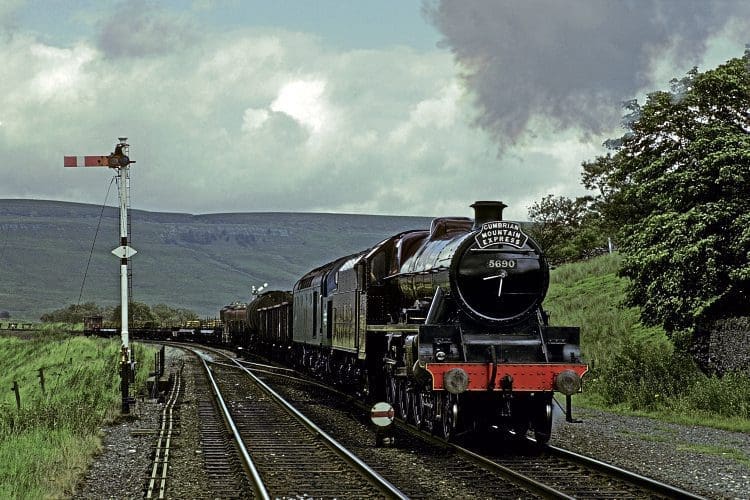
Its main line revival was quite brief and October 12, 1989 saw it transferred to the Great Central Railway where it worked for several years apart from occasional visits to other heritage lines. In 1994 No. 5593 was painted black and briefly carried the identity and livery of class pioneer No. 5552 Silver Jubileefor the silver jubilee of the preserved GCR. After a period as a static exhibit at Barrow Hill Roundhouse, Kolhapurhas returned to Tyseley and although a further overhaul is a possibility, it is not considered a priority.
BR black livery
No. 5690 Leanderreturned to steam in October 2014 unexpectedly in BR black mixed traffic livery as carried by class members in the early 1950s. The engine remains in the ownership of the Beet family, and is operated by the West Coast Railway Company from its Carnforth base, where Chris Beet is locomotive engineer. It returned to main line service in early 2015.
During 2012 an application was made by the Bahamas Locomotive Society to the Heritage Lottery Fund to enable the overhaul of No. 45596 Bahamasto be undertaken by contractors to speed the process of its return to working order. The bid was successful, and by December 2013 work had commenced at Tyseley with completion expected later this year or early next.
So Tyseley has now played a major part in keeping the spirit of all four preserved Jubilees alive, having overhauled its own No. 5593 Kolhapur,been the base for No. 45699 Galateaduring the first attempt at restoration in the 1990s, assisted Dr Beet in getting No. 5690 Leanderback on the main line again in 2005 and now carrying out a full overhaul of
No. 45596 Bahamas.
In 2017, 50 years after the last three Jubilees went out in style, hauling the 10.17 Leeds – Carlisle and the relief Down ‘Thames-Clyde Express’ every Saturday throughout the summer, we can still regularly enjoy the sights and sounds of two Jubilees on the route. They may be one-time Bristol engines; one red and one black, but the double-chimneyed green one will be back soon.
Read more News and Features in Heritage Railway magazine – on sale now!
Archive enquiries to: Jane Skayman on 01507 529423 – [email protected]k
Advert
 Enjoy more Heritage Railway reading in the four-weekly magazine. Click here to subscribe.
Enjoy more Heritage Railway reading in the four-weekly magazine. Click here to subscribe.




